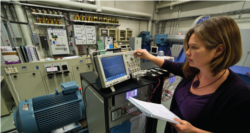 |
Country: Norway |  |
||
| Get funded free access to this facility via the ERIGrid 2.0 Lab Access Programme. |
||||
| Submit Testing/Consulting Request | ||||
Description: SINTEF Energy Research is part of the SINTEF Group, one of the largest non-profit research organizations in Northern Europe. SINTEF Energy Research is engaged in contract research in the national and international marketplace. Its R&D activities are focused on power production and energy converting, and also transmission and use of energy, including industrial processes and products, indoor climate and energy use in buildings. Issues concerning the deregulation of the electricity markets in Scandinavia and other parts of the world have for many years been a main activity. Contributions are also made to different energy related problems, which may arise onshore and offshore. These tasks range from system analysis to component and equipment assessments. SINTEF Energy Research has a staff of about 230 that ensures close co-operation between power engineering and mechanical engineering and focuses particularly on environmental issues. The institute has been a major actor on the energy research arena in the EU for many years.
SINTEF Energy Research has completed and participated in many national and transnational projects dealing with research related to energy systems. This involves e.g. market studies, energy system modelling and simulation as well as the small and large-scale integration of renewable energy systems into the grid. The department is also responsible for research and development of several market simulation and hydrothermal scheduling models that are used by almost all of the Scandinavian market players, TSOs and the Norwegian regulator.
A special part of this is the work with smart grids, channelled in the group of Active Grids. The group has a long experience with power quality and reliability measurement and management, end-user characterisation, and active use of new communication technology and innovative market solutions.
Facilities:
National Smartgrid Laboratory
Description:The National Smart Grid Laboratory (NSGL) is located in Trondheim at the campus of the Norwegian University of Science and Technology (NTNU) and jointly operated by SINTEF and NTNU. The laboratory has been recently refurbished and is under upgrade with state of the art solutions/technologies. The laboratory mainly consists of three platforms: the smart network testing facility, the smart house demonstration and the distributed energy storage infrastructure.
The facility covers an area of 300m²
Technical specifications (PDF)
Description: The Heliosi Characterisation facility is closely connected to the Heliosi Crystallisation facility and consists of a range of characterisation tools to determine electronic- and structural properties as well as chemical composition of crystalline PV Silicon by means of a series of established techniques and methods during development.
Technical specifications (PDF) Heliosi Crystallisation
Description: The Heliosi Crystallisation facility consists of two Bridgman furnaces for solidification of multicrystalline (mc) Si and one Czochralski furnace for monocrystalline (sc) Si. In the first half of 2010, the laboratory will also be provided with a new Czochralski furnace.
Technical specifications (PDF)
Windpower Lab/ Smartgrid Lab
Description: A Renewable Energy System Laboratory has been established jointly by SINTEF Energy Research and NTNU. It consists of power converters and rotating machines, and can be used for the following research:
- Component oriented research: test running of electrical machine prototypes and experiments with control methods for grid connected converters.
- Power grid related research: transient and fault handling in power systems, fault ride through for various loads and sources, and network operation and protection during weak grid and islanding conditions.
The laboratory can also be used for experiments regarding operation and fault handling in converter dominated systems.
Simulation and Optimisation Tools:- Real-Time Digital Simulators
- Hardware-in-the-Loop (HIL) testing equipment
- Rapid Control Prototyping (RCP) systems (OPAL-RT)
last updated: 04.04.2017
